|

Portland Beach Road
Back To Home Page Back To Navigation Page
This web page covers the main road and adjacent beaches from Ferrybridge, where Portland and Weymouth meet, down to the National Sailing Academy.
Features on this page include the Ferrybridge Hotel which, although in Weymouth, is a prominent landmark for visitors to Portland. It is currently closed for redevelopment.
Also featured are Hamm Beach which is very popular with wind surfers on the east side of the main road and the Chesil Beach (or Chesil Bank) on the west side of the main road.
Please click here for a detailed street map. Click the BACK button on your browser to return to this page.
Please click here for a Google Streetview of the area. Click the BACK button on your browser to return to this page.
Please click here to visit the satellite image of this area on Google Maps. Click the BACK button on your browser to return to this page.
|
Please use this table to navigate around this page
|
|
FERRYBRIDGE [1]
|

|
|
FERRY BRIDGE HOTEL [1]
|

|
|
SMALLMOUTH BEACH [2]
|

|
|
THE CHESIL BEACH CENTRE AND SURROUNDING AREA [3]
|

|
|
DISUSED RIFLE RANGE [3]
|

|
|
HAMM BEACH [4]
|

|
|
BILLY WINTERS BAR AND DINER [4]
|

|
|
CHESIL BEACH [5]
|

|
|
OIL STORAGE TANKS [6]
|

|
|
STORM DEFENCE CULVERT [7]
|

|
|
BOUNDARY STONE [8]
|

|
|
ANOTHER OF MY HOBBIES
|

|
|
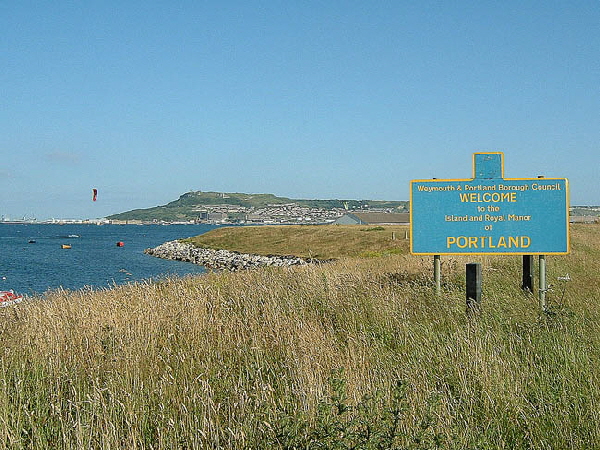
The original sign marking the start of the Royal Manor of Portland.
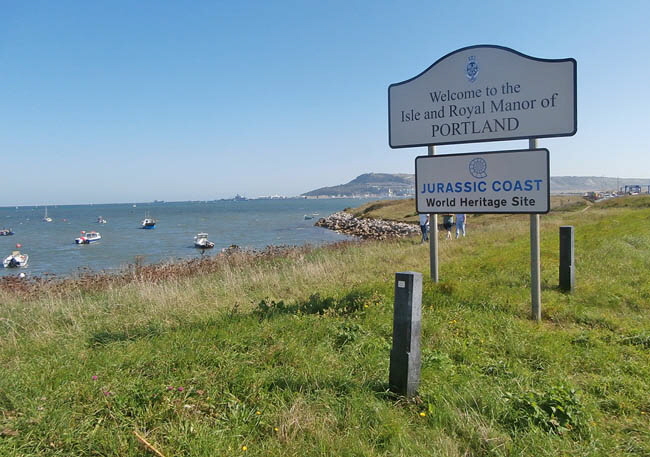
The latest sign as seen in 2015.
Return To Top Of Page
FERRYBRIDGE [1]
There are excellent histories of this treacherous passage between Portland and mainland England. See, for example, Stuart Morris’s book “Portland - An Illustrated History”, Ashley Smith’s “Encyclopedia of Portland History” website - please click here and two books; “A History Of Wyke Regis” published as a paperback in 1997 by Doug Hollings and “All About Ferry Bridge (or "Smallmouth") - The Link Between the Parish of Wyke Regis and the Island and Royal Manor of Portland” published as a paperback in 1993 also by Doug Hollings.
Before 1839 there was no road connection between Portland and the rest of England. The crossing was very dangerous. People and animals were carried in a small boat using ropes stretched across the gap. Portlanders rarely had an need to travel to Weymouth and beyond. Even into the 1970s there were locals who claimed never to have left Portland.
The crossing of The Fleet could be extremely dangerous due to strong currents in the Smallmouth Passage. At low tide, a sand bar situated at Ferry Bridge acted as an alternative way for people to cross the passage between the mainland and Portland.
"The Great Gale of 1824" caused major destruction across the village of Chiswell, as well as at the Smallmouth Passage.
The Ferry House was destroyed and the ferryman, Richard Best, was drowned.
This disaster led to calls for a bridge to be built and the picture below shows the first Ferry Bridge.
This bridge was replaced by a steel bridge in 1896.
The above aerial photograph shows the Whitehead Torpedo Works in the centre of the image. The entrance to The Fleet lagoon passed immediately south of The Ferrybridge Inn until the present bridge was built when the Fleet entrance was moved some distance south.
The steel bridge was itself demolished and replaced by a concrete span bridge in 1985.
The replacement of the old bridge became a matter of urgency when an inspection showed it to be in a dangerous state with the risk of collapse under the weight of the huge lorries for which it was never designed.
This was a remarkable engineering feat as the main road had to be kept open whilst the new bridge was built and the old bridge demolished. During this process I commuted between Weymouth and Portland every day and failed to see how the new layout of the road and new bridge was going to meet up at the Ferrybridge Inn.
But, of course, it did and now there is no evidence to show the line of the old road.
This was the original entrance to the Fleet which flowed immediately in front of the Ferrybridge Inn at the centre of the picture. The entrance was moved further south to flow under the new bridge.
In 1865 the railway was built to Portland and it passed over a viaduct at Smallmouth. This was demolished in 1971.
The railway had a run of bad luck in the ten years from 1868. In that year a drunken fisherman fell between a locomotive and the carriages and was killed. The following year a man committed suicide by laying on the track as a train approached. In 1870 a sailor was killed whilst walking on the track and in 1876 a runaway train roared through Chiswell Station and crashed into the buffers at the end of the line injuring many passengers. In 1878 two trains collided and again many passengers were injured.
This picture shows the track of the railway as it headed south over the old entrance to the Fleet Lagoon and went over the old viaduct bridge.
At the centre of this picture we see one of the steel pillars that supported the viaduct which has been cut off at ground level and left.
Return To Top Of Page
FERRY BRIDGE HOTEL [1]
The Ferry Bridge Hotel was originally named The Royal Victoria Hotel as seen in this picture below. This must have caused confusion as the last pub in the mainland when heading to Portland had the same name as the first pub encountered on Portland.
The Ferry Bridge Hotel shown before it closed in 2015 to be demolished and redeveloped.
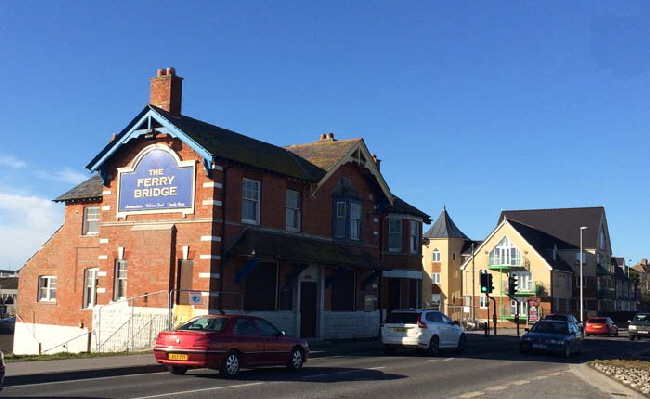
The Ferry Bridge Hotel shut up and looking very sad in 2018.
Return To Top Of Page
SMALLMOUTH BEACH [2]
The Fleet used to meet Portland Harbour at this point and the area where the people are paddling was, for many centuries, a dangerous fast-flowing body of water. This area became a safe haven for swimmers and sand castle builders in the 1980s when the Fleet exit was diverted further south and the new Ferry Bridge was built.
The Weymouth to Portland Railway used to run on the spur of land in the mid-distance and then go on a viaduct to the other side of the Fleet entrance.
Return To Top Of Page
THE CHESIL BEACH CENTRE AND SURROUNDING AREA [3]
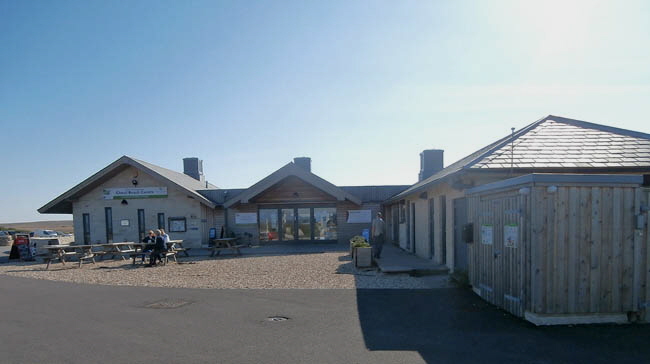
The Fine Foundation Chesil Beach Centre website can be seen here.
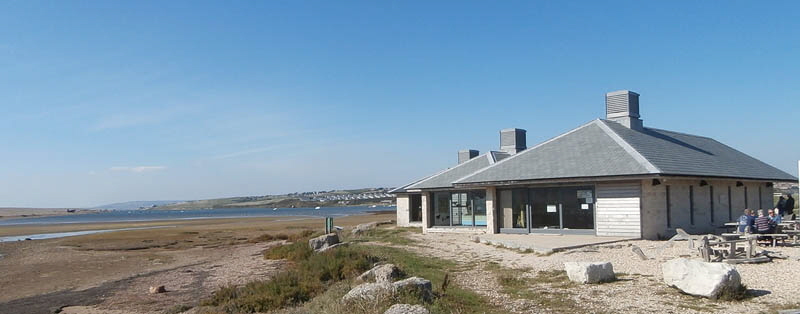
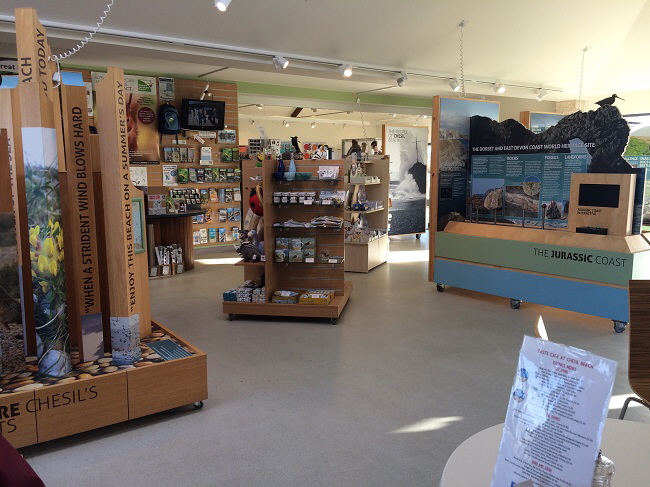
The Centre has a large area of displays explaining the local environment as well as binoculars which can be used to watch the local birds feeding on the mud flats.
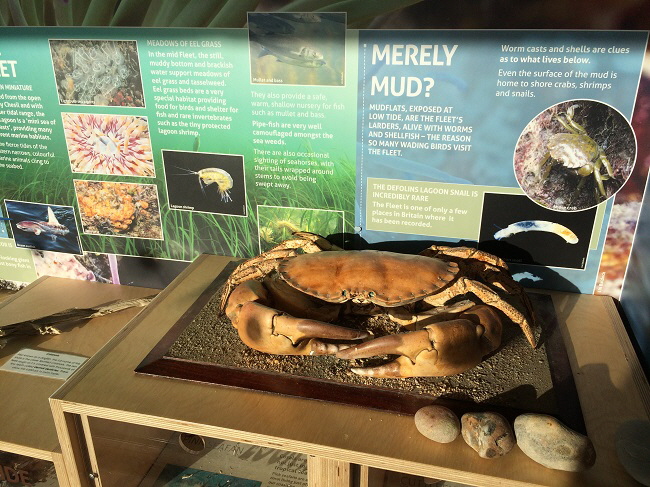
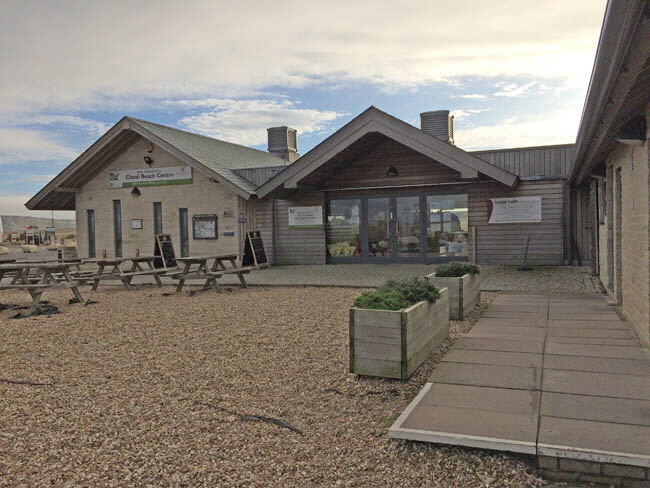
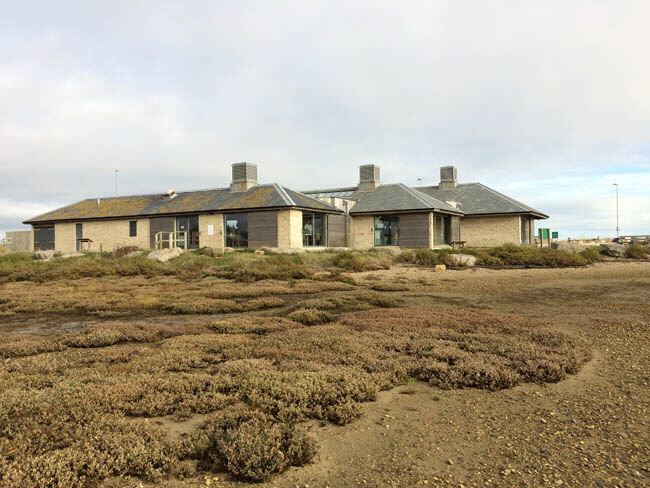
Low tide at the Centre.
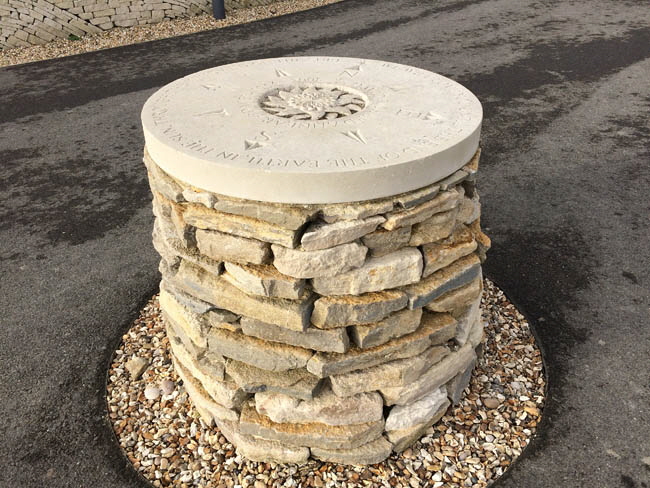
A finely carved plinth showing the points of the compass.

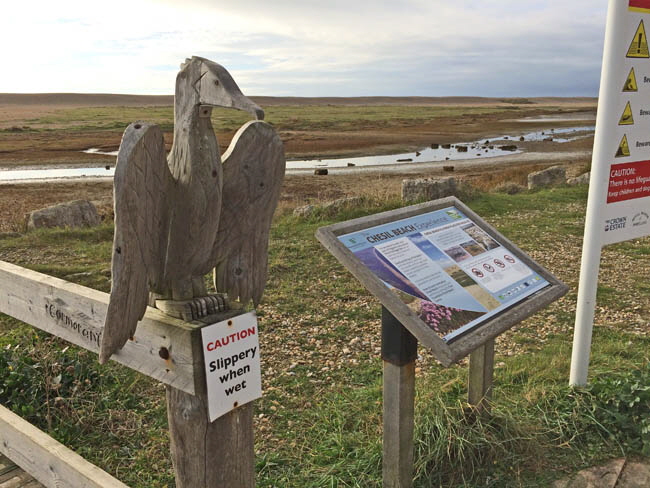
A wooden Cormorant watches over the board walk.
Return To Top Of Page
DISUSED RIFLE RANGE [3]
The Chesil Beach has been used extensively by the armed forces. Over the years there has been a rifle range, a system for testing ships’ anchors and various other beach defence structures.
Wandering over Chesil Beach will reveal the remains of these and other artefacts.

The rifle range from the early twentieth century.
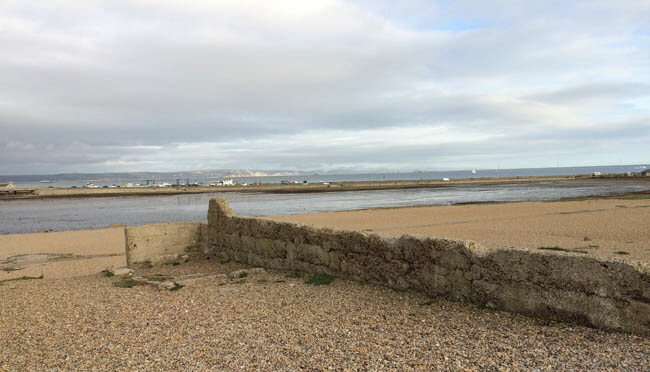
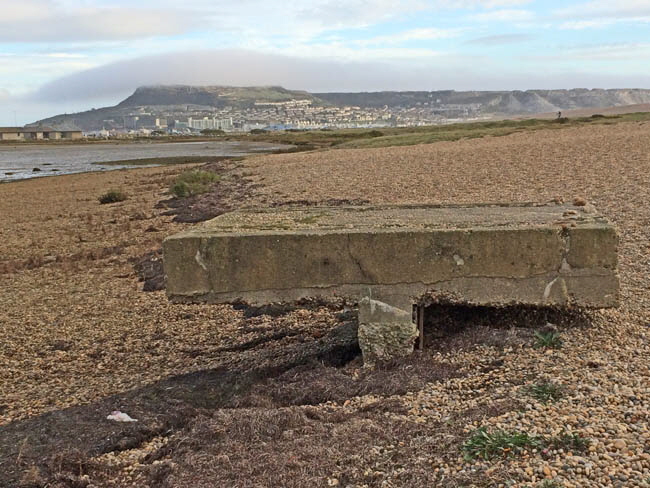
This may be part of the Royal Naval Anchor Testing facility from early in the 20th century.
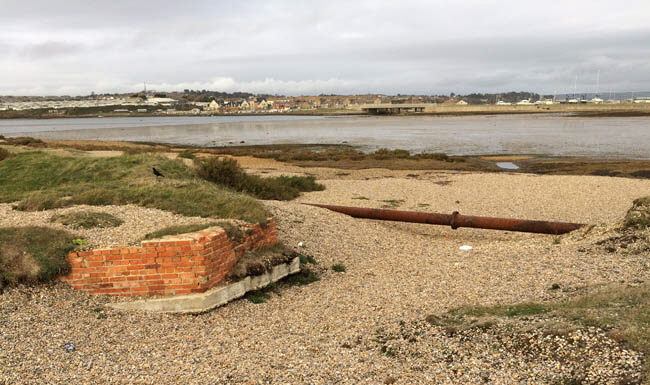
An old utility pipe has been exposed by easterly gales.
Return To Top Of Page
HAMM BEACH [4]
Hamm Beach is the coastal strip on the Portland Harbour side of the Beach Road. The railway ran on this coastal strip as seen above.
In the Spring the grass area adjacent to Hamm Beach is ablaze with Sea Thrift (also known as Pink)
This plant was featured on the pre-decimal three pence coin as shown below.
Return To Top Of Page
BILLY WINTERS BAR AND DINER [4]
On the eastern shore of Hamm Beach close by the Ferry Bridge is Billy Winters Bar and Diner - please click here for details. This is a quirky place to drink and dine as it appears to be set up in a temporary hut. However, like the TARDIS, it is much larger on the inside than it appears on the outside.
It is always enjoyable in fine weather to sit outside on wooden benches drinking and enjoying the excellent sea food whilst soaking up the sunshine and views along the Jurassic Coast.
Return To Top Of Page
THE CHESIL BEACH [5]
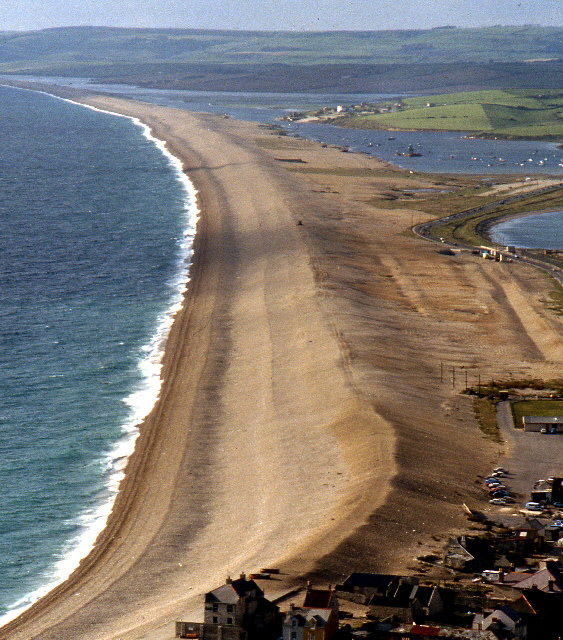
© Copyright Crispin Purdye and licensed for reuse under this Creative Commons Licence.
There is a website site by the Dorset Wildlife Trust devoted to The Chesil Beach which can be visited here. This a geological feature called a Tombolo. In fact it is the largest Tombolo on the planet.
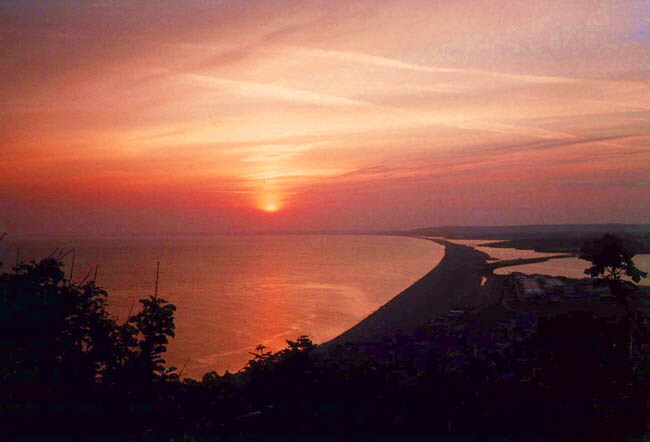
This view of the setting mid-summer sun shows the Chesil Beach stretching away towards Burton Bradstock and West Bay.
Chesil Beach is 18 miles (28 kilometres) long and about 160 metres wide and 12 metres in height on average. There is an authoritative article on this feature here.
It is estimated that Chesil Beach contains about 180 billion pebbles. As an aside, the UK government debt amounted to nearly £2 billion. This means that more than ten Chesil Beaches made up of one pound coins for each pebble would be needed to pay off our national debt.
Put another way, if the national debt were converted to one pound coins and piled up in the sea off Portland it would look like the above picture. Scared? You should be! But enough of freaky national economics...
Return To Top Of Page
OIL STORAGE TANKS [6]
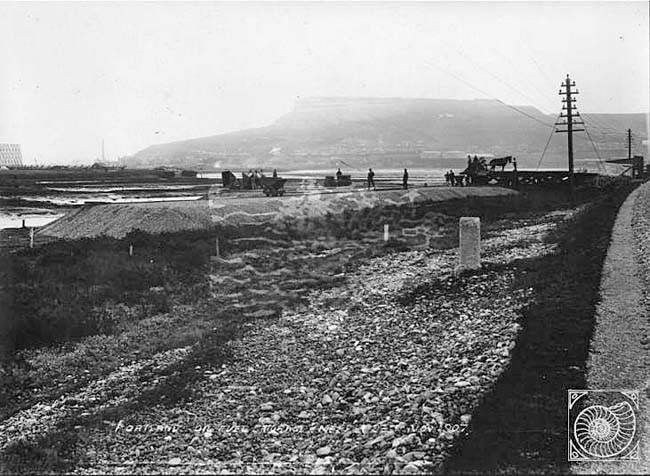
A major feature of the area throughout the 20th century was the array of oil storage tanks. The pictures above and below show the tanks being constructed in 1905.
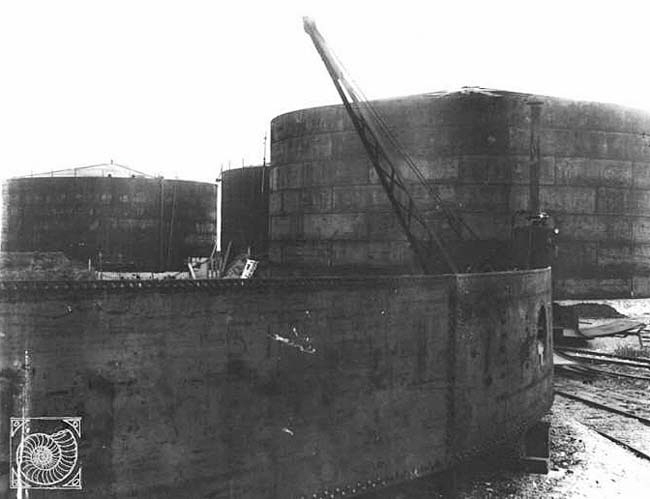
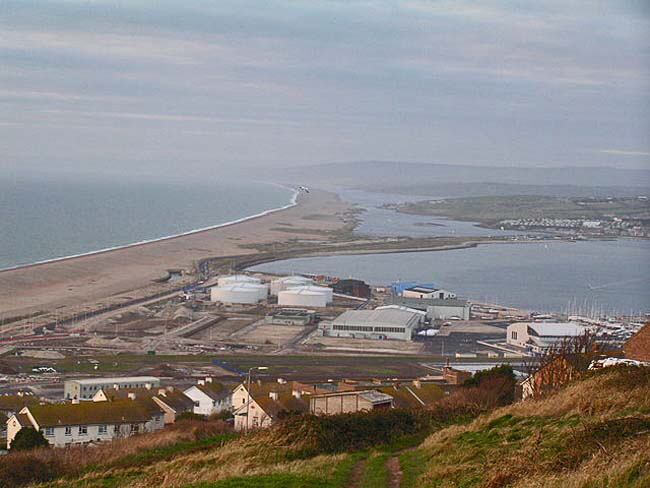
© Copyright N Chadwick and licensed for reuse under this Creative Commons Licence.
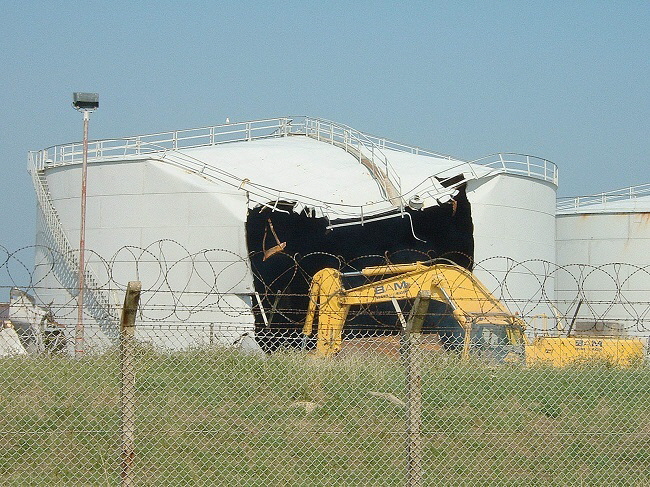
When it was announced that the 2012 Olympic sailing events were to come top Portland it was decided to demolish the tanks and by 2012 they were removed.
You can view a video by Stuart Morris of the last of the tanks being demolished here.
Return To Top Of Page
STORM DEFENCE CULVERT [7]
At the southern end of the Portland Beach Road a huge culvert was built to capture and drain into Portland Harbour the water that comes flooding over the Chesil Beach during storms.
In addition the road nearby was raised by one metre to reduce the risk of the main road being blocked by flood waters
This latter was an interesting engineering exercise as a temporary road had to be built on the shingle parallel to the main road whilst the latter was raised. There is now no sign of this temporary road.
When there is a severe storm, as in early 2014, this culvert fills up and diverts the water into Portland Harbour.
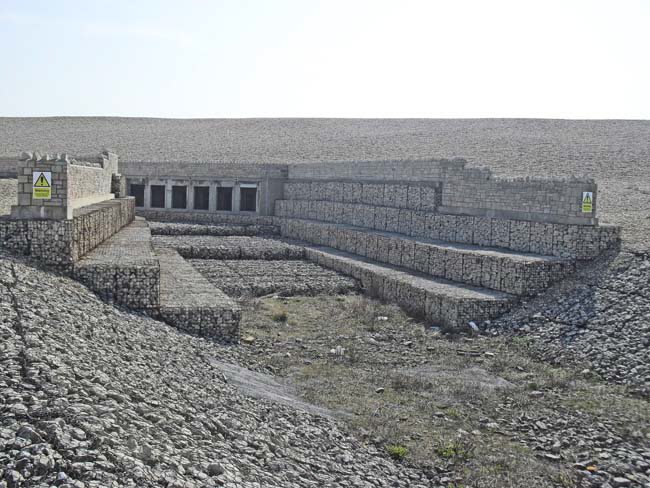
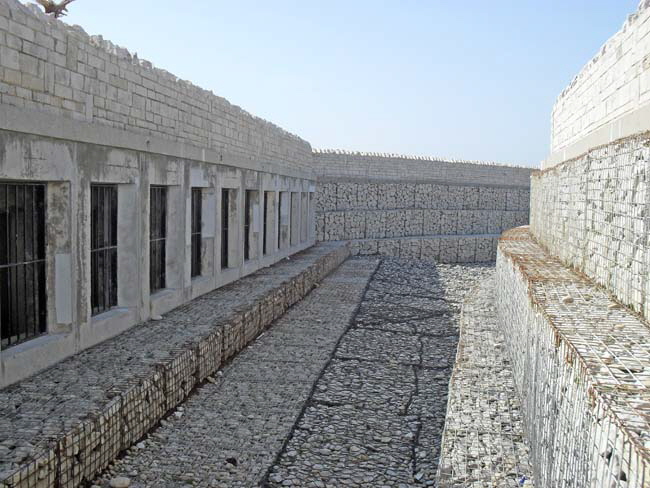
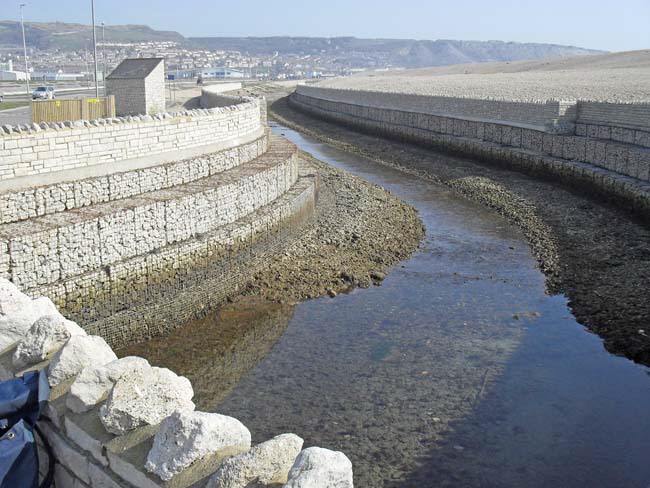
The aftermath of a storm.
Return To Top Of Page
BOUNDARY STONE [8]
High on the crest of Chesil Beach near the Chesil Beach Centre is a boundary stone marking the change of responsibility from Portland to Weymouth. Every year the ceremony of the ‘Beating Of The Bounds’ used to be performed with the ceremonial beating of a small lad laid over the stone.
The above picture was taken in 1935.
Here we see the Portland Town Mayor, Edward John Flew, placing a Reeve Staff on the boundary stone in 1935.
Return To Top Of Page
ANOTHER OF MY HOBBIES

Age of 75 I started a new hobby - writing and publishing books. These are available as paperbacks from Amazon - please click here for details. Their overall star rating from readers is 
Keywords Ferrybridge Hotel Billy Winters Oil Tanks Hamm Beach Smallmouth Beach Portland Dorset
|